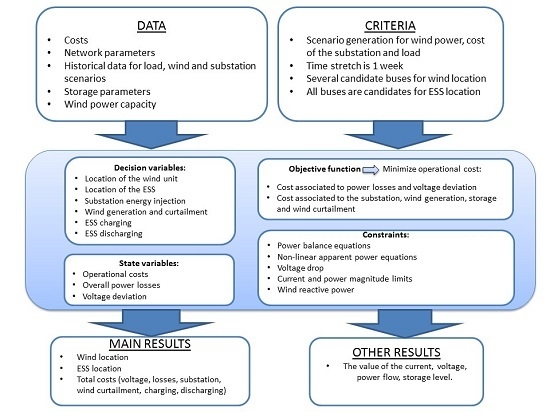Optimal Placement of Energy Storage and Wind Power under Uncertainty
Abstract
:1. Introduction
- (1)
- Regarding the methodology, a stochastic mixed integer linear programming (MILP) model is introduced to consider the inconsistency and intermittency of renewable power sources, in this case wind power. The MILP method applied provides these benefits:
- (a)
- The mathematical model is robust.
- (b)
- The computational behavior of a linear solver is more efficient than those of nonlinear solvers, providing a global optimum solution.
- (c)
- Convergence can be guaranteed using classical optimization techniques.
- (2)
- From a modeling perspective, a novel joint RES and EES optimal location model, which has not been done yet, is presented here for a distribution system.
2. Scenario Generation and Storage Modeling
2.1. Scenario Generation
2.2. Generic Energy Storage Systems Modeling
- There are no up or down ramps.
- There are no storage energy losses.
- There is no hysteresis in discharging or charging.
- There are conversion losses. This means there are efficiency rates of direct (production) and reverse (storage) energy transformation. These rates are given with respect to the energy measured at the bus connected to the storage unit.
- Production/storage costs are the same for any level of production/storage of the unit.
- Energy production/storage occurs at constant power for the minimum period of study (typically one hour).
- The depth of discharge is assumed to be 80% of the maximum storage energy capacity.
3. Mixed Integer Linear Programming Formulation
- The electric distribution system is a balanced three-phase system and can be represented by its equivalent single-phase circuit.
- The time stretch used for the simulation is one week, in intervals of time of 1 h.
- Several candidate buses are selected for the optimal location of the wind unit. The optimal locations, based on wind resources, should be selected according to: high average speed, acceptable diurnal and seasonal variations, acceptable levels of turbulence and extreme winds. Other technical criteria are the softness of the orography for the civil works and the proximity of power lines with evacuation capacity for interconnection, technical feasibility and ease of construction or absence of environmental, urban, archaeological and cultural conditions.
- In the case of locating ESS, all the buses are candidates for location.
- For the sake of simplicity, only one wind power unit and one ESS unit are used. The variation of the installed amount of wind and ESS capacities at the optimal locations is discussed in the case study.
3.1. Objective Function
3.2. Constraints
3.2.1. Power Balance Equations
3.2.2. Non-Linear Apparent Power Equations
3.2.3. Voltage Drop Equations
3.2.4. Current and Power Magnitude Limits
3.2.5. Wind Reactive Power Equations
3.3. Linearization Procedure
- : the left side of Equation (14) is handled by dividing into small segments. Nevertheless, this leads to an increase in the number of binary variables and computation time. In distribution systems, voltage magnitudes are within a small range, so a constant value can be approximated as the voltage magnitude for the first run of the model, in which binary variables are relaxed [27], as seen in Equation (35):Next, the model is run again and takes the value resulting from the first run. Note that hardly changes after the second run. Because of the limited range of voltage magnitude variation, this simplification has a small error.
- : both terms on the right side of (Equation (14)) are handled by introducing a piecewise linear approximation [28]. The linearization process is the following:where:Equation (36) is a piecewise linear approximation of (), and Equations (37) and (38) represent that () and () are equal to the sum of the values in each block of the discretization, which means they are a set of linear terms. In addition, and are constant parameters, and Equations (37) and (38) are linear expressions. Thus, Equation (43) represents the final linear form of constraint in Equation (14). In this equation, is a parameter and and are linear. The linearization of the active power Equation (14) is shown in Figure 5:
4. Case Studies
4.1. Network Overview
4.2. Simulation Results
5. Conclusions
Acknowledgments
Author Contributions
Conflicts of Interest
Notations
Indexes
| i,j,k | Bus indexes |
| r | Piecewise linearization (PWL) block index |
| t | Real-time period index on a 10-min basis |
| ω | Scenario index |
Parameters
Power losses penalization cost ($/MWh) | |
Production cost of the storage unit ($/MWh) | |
Storage cost of the storage unit ($/MWh) | |
Cost of real power from substation ($/MWh) | |
Voltage deviation penalization cost ($/MWh) | |
Wind curtailment cost ($/MWh) | |
Maximum current flow through branch ij (A) | |
Number of storage units in the distribution network | |
Number of wind units in the distribution network | |
Wind power forecast at node i, period t and scenario ω (MW) | |
Reactive power demand at node i, period t and scenario ω (MVaR) | |
Resistance of branch ij (Ω) | |
Nominal voltage of the distribution network (kV) | |
| , | Minimum/maximum production of the storage unit at node i (MW) |
| , | Minimum/maximum storage of the unit at node i (MW) |
Nominal voltage of the distribution network (kV) | |
| , | Minimum/maximum storage capacity at node i (MWh) |
| Δ | Time period (1 h) (h) |
| , | Efficiency production/storage rates of the storage units at node i |
Variables
Conjugate value of the current flow through branch ij (A) | |
Phasor magnitude of the current flow through branch ij (A) | |
Square of the current flow through branch ij (A2) | |
Slope of the r-th block of the PWL | |
Real power of the substation (MW) | |
Real power flow (downstream) (MW) | |
Real power flow (upstream) (MW) | |
Real power wind curtailment at bus i (MW) | |
Real power of wind turbine at bus i (MW) | |
Square value of the real power flow (MW2) | |
Power factor of the wind generation | |
Reactive power of wind turbine at bus i (MVaR) | |
Reactive power of the substation (MVaR) | |
Reactive power flow (downstream) (MVaR) | |
Reactive power flow (upstream) (MVaR) | |
Square value of the reactive power flow (MVaR2) | |
Reactive power of wind turbine at bus i (MVaR) | |
Scheduled power production/storage reserve (MW) | |
Scheduled power production/storage reserve (MW) | |
Phasor magnitude of the voltage (kV) | |
Square of the voltage magnitude of node i (kV2) | |
Binary variable related to real power (upstream) | |
Binary variable related to real power (downstream) | |
Binary variable related to reactive power (upstream) | |
Binary variable related to reactive power (downstream) | |
Storage level at node i (MWh) | |
Binary variable for wind power unit location | |
Binary variable for storage unit location | |
Total cost of power losses and voltage deviation ($) | |
Total costs of wind and demand curtailments and ESS operation ($) | |
Value of the r-th block of real power (MW) | |
Value of the r-th block of reactive power (MVaR) | |
Value of the r-th block of apparent power (MVA) | |
Phasor of the angle (rad) |
References
- Ackermann, T.; Andersson, G.; Söder, L. Distributed generation: A definition. Electr. Power Syst. Res. 2001, 57, 195–204. [Google Scholar] [CrossRef]
- Liu, Z.; Wen, F.; Ledwich, G. Optimal siting and sizing of distributed generators in distribution systems considering uncertainties. IEEE Trans. Power Deliv. 2011, 26, 2541–2551. [Google Scholar] [CrossRef]
- Korpaas, M.; Holen, A.T.; Hildrum, R. Operation and sizing of energy storage for wind power plants in a market system. Int. J. Electr. Power Energy Syst. 2003, 25, 599–606. [Google Scholar] [CrossRef]
- Halamay, D.A.; Brekken, T.K.A.; Simmons, A.; McArthur, S. Reserve requirement impacts of large-scale integration of wind, solar, and ocean wave power generation. IEEE Trans. Sustain. Energy 2011, 2, 321–328. [Google Scholar] [CrossRef]
- Vázquez, M.A.O.; Kirschen, D.S. Estimating the spinning reserve requirements in systems with significant wind power generation penetration. IEEE Trans. Power Syst. 2009, 24, 114–124. [Google Scholar] [CrossRef]
- Srivastava, A.K.; Kumar, A.A.; Schulz, N.N. Impact of distributed generations with energy storage devices on the electric grid. IEEE Syst. J. 2012, 6, 110–117. [Google Scholar] [CrossRef]
- Barton, J.; Infield, D. Energy storage and its use with intermittent renewable energy. IEEE Trans. Energy Convers. 2004, 19, 441–448. [Google Scholar] [CrossRef]
- Schainker, R. Executive overview: Energy storage options for a sustainable energy future. In Proceedings of the IEEE Power Engineering Society General Meeting, Denver, CO, USA, 10 June 2004.
- Leonhard, W.; Grobe, E. Sustainable electrical energy supply with wind and pumped storage—A realistic long-term strategy or Utopia? In Proceedings of the IEEE Power Engineering Society General Meeting, Denver, CO, USA, 10 June 2004.
- Georgilakis, P.S.; Hatziargyriou, N.D. Optimal distributed generation placement in power distribution networks: Models, methods, and future research. IEEE Trans. Power Syst. 2013, 28, 3420–3428. [Google Scholar] [CrossRef]
- Kumar, A.; Gao, W. Optimal distributed generation location using mixed integer non-linear programming in hybrid electricity markets. IET Gener. Transm. Distrib. 2010, 4, 281–298. [Google Scholar] [CrossRef]
- Gandomkar, M.; Vakilian, M.; Ehsan, A. Genetic-based tabu search algorithm for optimal DG allocation in distribution networks. Electr. Power Compon. Syst. 2005, 12, 1351–1362. [Google Scholar] [CrossRef]
- Ochoa, L.F.; Harrison, G.P. Minimizing energy losses: Optimal accommodation and smart operation of renewable distributed generation. IEEE Trans. Power Syst. 2011, 26, 198–205. [Google Scholar] [CrossRef]
- Hung, D.Q.; Mithulananthan, N. Multiple distributed generator placement in primary distribution networks for loss reduction. IEEE Trans. Ind. Electron. 2013, 60, 1700–1708. [Google Scholar] [CrossRef]
- Al Abri, R.S.; El-Saadany, E.F.; Atwa, Y.M. Optimal placement and sizing method to improve the voltage stability margin in a distribution system using distributed generation. IEEE Trans. Power Syst. 2013, 28, 326–334. [Google Scholar] [CrossRef]
- Othman, M.M.; El-Khattam, W.; Hegazy, Y.G.; Abdelaziz, A.Y. Optimal placement and sizing of distributed generators in unbalanced distribution systems using supervised Big Bang-Big Crunch method. IEEE Trans. Power Syst. 2015, 30, 911–919. [Google Scholar] [CrossRef]
- Karanki, S.B.; Xu, D.; Venkatesh, B.; Singh, B.N. Optimal location of battery energy storage systems in power distribution network for integrating renewable energy sources. In Proceeings of the IEEE Energy Conversion Congress and Exposition (ECCE), Denver, CO, USA, 15–19 September 2013.
- Atwa, Y.M.; El-Saadany, E.F. Optimal allocation of ESS in distribution systems with a high penetration of wind energy. IEEE Trans. Power Syst. 2010, 25, 1815–1822. [Google Scholar] [CrossRef]
- Akhavan-Hejazi, H.; Mohsenian-Rad, H. Optimal operation of independent storage systems in energy and reserve markets with high wind penetration. IEEE Trans. Smart Grid 2014, 5, 1088–1097. [Google Scholar] [CrossRef]
- Alnaser, S.W.; Ochoa, L.F. Optimal sizing and control of energy storage in wind power-rich distribution networks. IEEE Trans. Power Syst. 2015, 31, 2004–2013. [Google Scholar] [CrossRef]
- Ghofrani, M.; Arabali, A. A stochastic framework for power system operation with wind generation and energy storage integration. In Proceedings of the Innovative Smart Grid Technologies Conference (ISGT), Washington, DC, USA, 19–22 February 2014.
- Xu, Y.; Jewell, W.T.; Pang, C. Optimal location of electrical energy storage unit in a power system with wind energy. In Proceedings of the North American Power Symposium (NAPS), Pullman, WA, USA, 7–9 September 2014.
- Zhao, H.; Wu, Q.; Huang, S.; Guo, Q.; Sun, H.; Xue, Y. Optimal siting and sizing of energy storage System for power systems with large-scale wind power integration. In Proceedings of the Eindhoven PowerTech, Eindhoven, The Netherlands, 29 June–2 July 2015.
- Nick, M.; Hohmann, M.; Cherkaoui, R.; Paolone, M. Optimal location and sizing of distributed storage systems in active distribution networks. In Proceedings of the IEEE 2013 PowerTech, Grenoble, France, 16–20 June 2013.
- Meneses de Quevedo, P.; Allahdadian, J.; Contreras, J.; Chicco, G. Islanding in distribution systems considering wind power and storage. Sustain. Energy Grids Netw. 2016, 5, 156–166. [Google Scholar] [CrossRef]
- Pozo, D.; Contreras, J.; Sauma, E.E. Unit commitment with ideal and generic energy storage units. IEEE Trans. Power Syst. 2014, 29, 2974–2984. [Google Scholar] [CrossRef]
- Tabares Pozos, A.; Lavorato de Oliveira, M.; Franco Baquero, J.F.; Rider Flores, M.J. A mixed-binary linear formulation for the distribution system expansion planning problem. In Proceedings of the IEEE Transmission & Distribution Conference and Exposition—Latin America (PES T&D-LA), Medellin, Colombia, 10–13 September 2014; pp. 156–166.
- Meneses de Quevedo, P.; Contreras, J.; Rider, M.J.; Allahdadian, J. Contingency assessment and network reconfiguration in distribution grids including wind power and energy storage. IEEE Trans. Sustain. Energy 2015, 6, 1524–1533. [Google Scholar] [CrossRef]
- Chiang, H.; Jean-Jumeau, R. Optimal network reconfigurations in distribution systems. II. Solution algorithms and numerical results. IEEE Trans. Power Deliv. 1990, 5, 1568–1574. [Google Scholar] [CrossRef]
- Meteorología y climatología de Navarra. 2014. Available online: http://meteo.navarra.es/estaciones/mapadeestaciones.cfm (assessed on 8 July 2016).
- Red Eléctrica de España. SEIE: Demand and Generation Price. 2014. Available online: https://www.esios.ree.es/es (assessed on 8 July 2016).
- AECOM, Australian Renewable Energy Agency. 2015. Available online: http://arena.gov.au/files/2015/07/AECOM-Energy-Storage-Study.pdf/ (assessed on 8 July 2016).
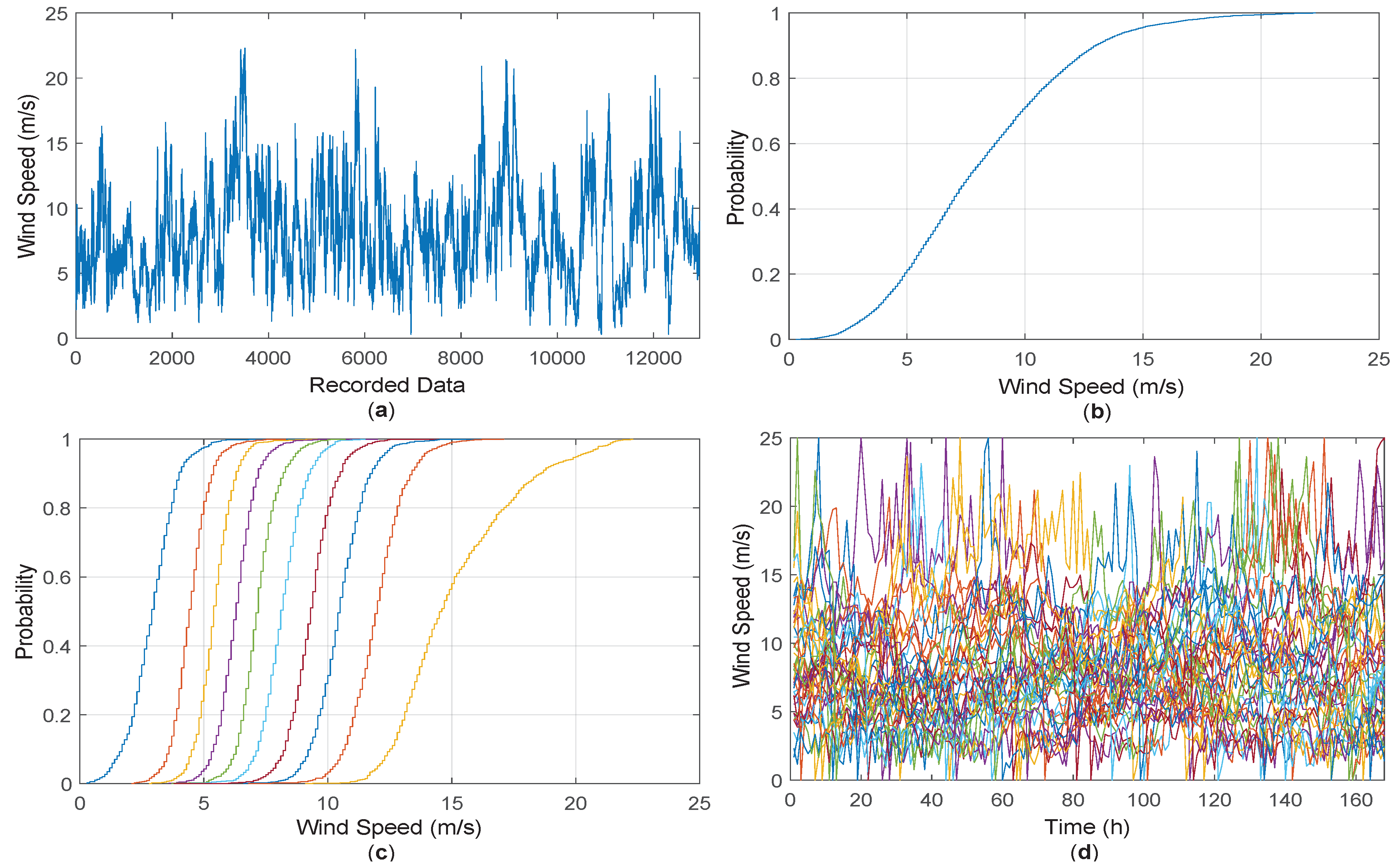


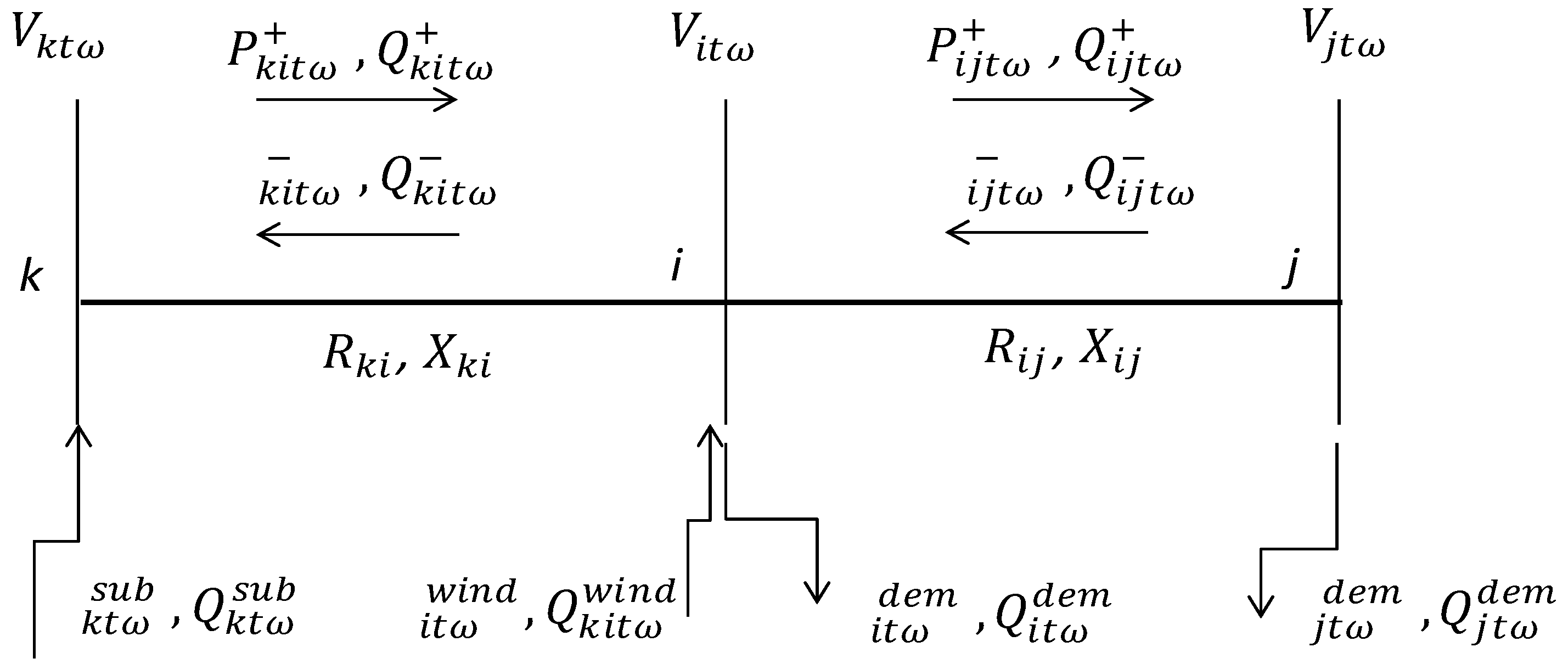
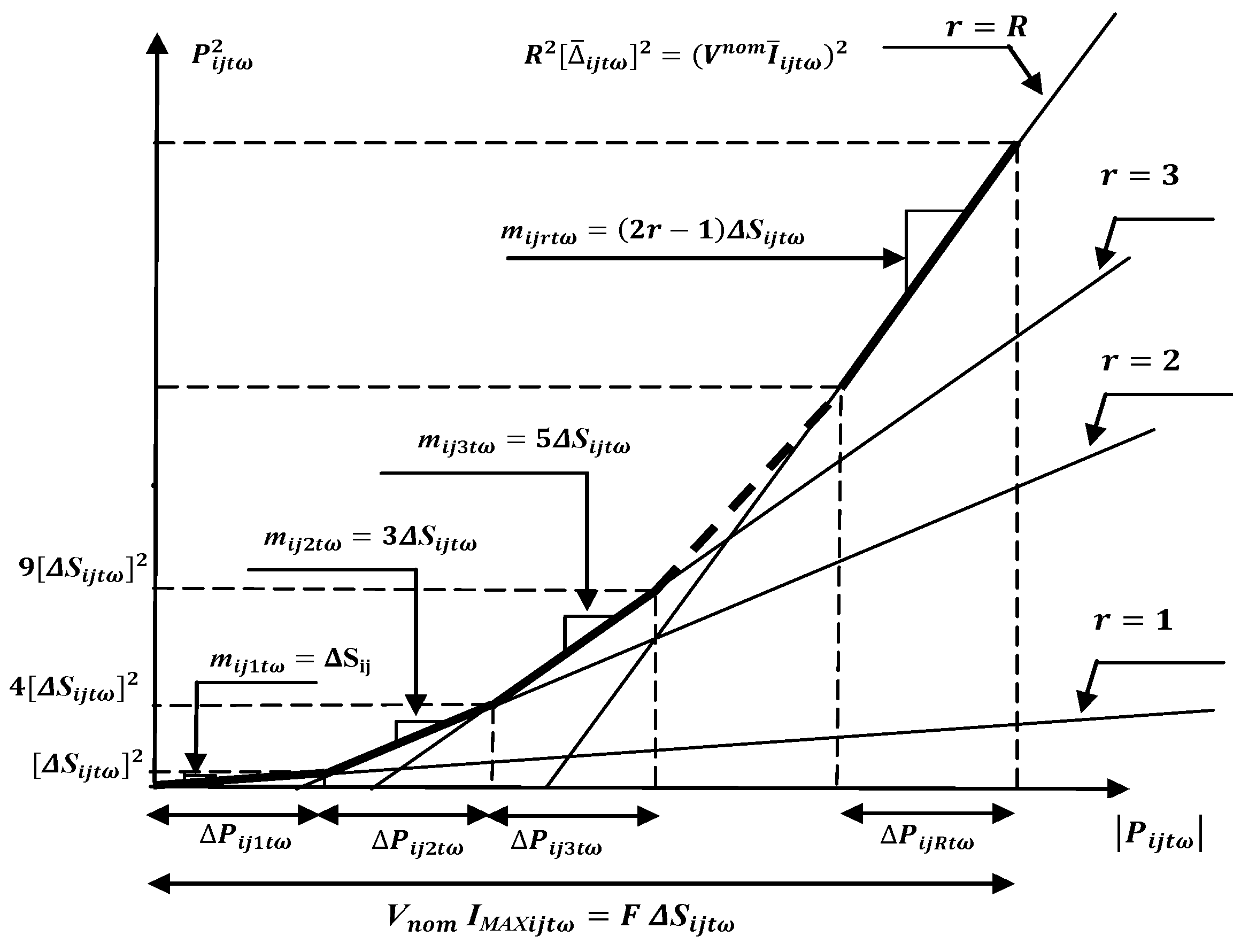

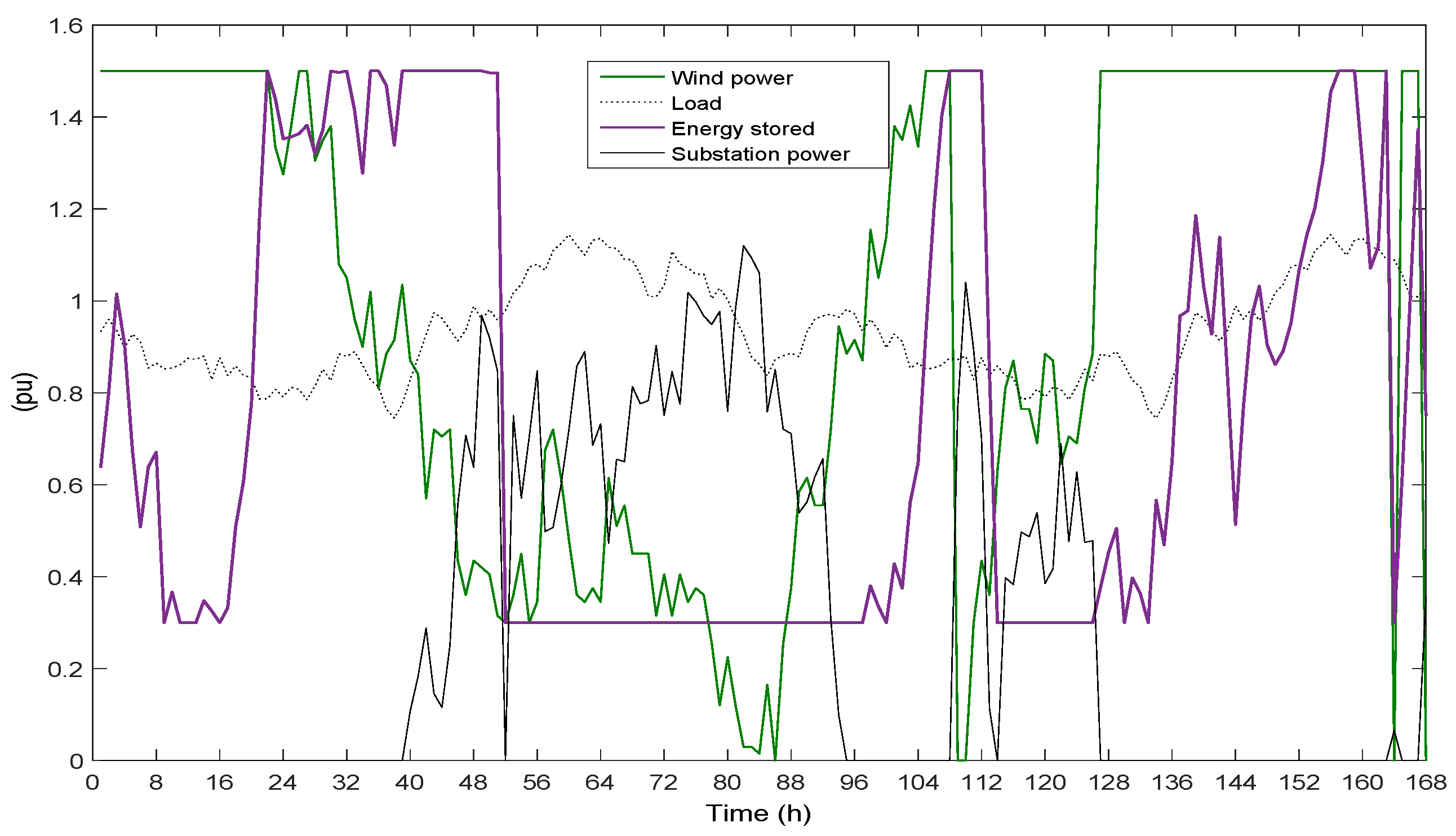
| Approach | Optimal Wind Site | Optimal ESS Site | Stochasticity | Objective Function | Methodology |
|---|---|---|---|---|---|
| [2] | √ | × | √ | Investment, operation, maintenance and losses costs minimization | CCP |
| [11] | √ | × | × | Fuel cost minimization | MINLP |
| [12] | √ | × | × | Power losses minimization | TS |
| [13] | √ | × | × | Power losses minimization | Multiperiod NL AC OPF |
| [14] | √ | × | × | Power losses minimization | Improved analytical method |
| [15] | √ | × | × | Voltage stability margin maximization | MINLP |
| [16] | √ | × | × | Multi-objective optimization (active, reactive power losses, voltage profile and reserve capacity minimization) | BB-BC |
| [17] | × | √ | × | Power losses minimization | PSO |
| [18] | × | √ | × | Wind energy maximization | NLP |
| [20] | × | √ | × | Overall capital cost | Multiperiod NLP AC OPF |
| [22] | × | √ | √ | Generation cost minimization | GA POPF |
| [23] | × | √ | √ | ESS, transmission losses and conventional generation cost minimization | NLP DC POPF |
| [24] | × | √ | √ | Multi-objective optimization (voltage deviation, network losses, energy cost minimization | GA |
| Proposed approach | √ | √ | √ | Expected value minimization of energy losses, voltage deviation, generation, wind curtailment and storage costs | MILP AC OPF |
| Values (pu) | Case 1 | Case 2 | Case 3 | Case 4 | Case 5 | Case 6 | Case 7 | Case 8 | Case 9 | Case 10 |
|---|---|---|---|---|---|---|---|---|---|---|
| Wind Power | 0 | 1 | 1 | 1 | 1 | 1.5 | 1.5 | 1.5 | 1.5 | 1.5 |
| ESS Capacity | 0 | 0.5 | 0.5 | 1 | 1 | 1 | 1 | 1.5 | 1.5 | 0 |
| ESS Max Power | 0 | 0.1 | 0.4 | 0.2 | 0.8 | 0.2 | 0.8 | 0.3 | 1.2 | 0 |
| Cases | Case 1 | Case 2 | Case 3 | Case 4 | Case 5 | Case 6 | Case 7 | Case 8 | Case 9 | Case 10 |
|---|---|---|---|---|---|---|---|---|---|---|
| Wind Location | - | 62 | 62 | 62 | 62 | 62 | 62 | 62 | 62 | 62 |
| ESS Location | - | 62 | 62 | 62 | 62 | 9 | 9 | 62 | 62 | - |
| Costs ($) | Case 1 | Case 2 | Case 3 | Case 4 | Case 5 |
|---|---|---|---|---|---|
| Total | 27,170 | 14,294 | 14,236 | 14,193 | 14,118 |
| Voltage | 120 | 70 | 71 | 70 | 72 |
| Losses | 147 | 110 | 102 | 102 | 95 |
| Substation | 26,902 | 14,114 | 14,063 | 14,021 | 13,951 |
| Wind curtailment | - | - | - | - | - |
| Discharging | - | 0.85 | 1.89 | 1.49 | 2.64 |
| Charging | - | 1.04 | 2.34 | 1.84 | 3.26 |
| Costs ($) | Case 6 | Case 7 | Case 8 | Case 9 | Case 10 |
| Total | 10,395 | 10,250 | 10,121 | 10,025 | 15,471 |
| Voltage | 59 | 64 | 70 | 69 | 148 |
| Losses | 140 | 137 | 112 | 107 | 296 |
| Substation | 10,196 | 10,049 | 9,940 | 9,849 | 10,493 |
| Wind curtailment | - | - | - | - | 4,534 |
| Discharging | 5.34 | 15.60 | 5.98 | 20.68 | - |
| Charging | 6.60 | 19.26 | 7.38 | 25.53 | - |
© 2016 by the authors; licensee MDPI, Basel, Switzerland. This article is an open access article distributed under the terms and conditions of the Creative Commons Attribution (CC-BY) license (http://creativecommons.org/licenses/by/4.0/).
Share and Cite
Meneses de Quevedo, P.; Contreras, J. Optimal Placement of Energy Storage and Wind Power under Uncertainty. Energies 2016, 9, 528. https://doi.org/10.3390/en9070528
Meneses de Quevedo P, Contreras J. Optimal Placement of Energy Storage and Wind Power under Uncertainty. Energies. 2016; 9(7):528. https://doi.org/10.3390/en9070528
Chicago/Turabian StyleMeneses de Quevedo, Pilar, and Javier Contreras. 2016. "Optimal Placement of Energy Storage and Wind Power under Uncertainty" Energies 9, no. 7: 528. https://doi.org/10.3390/en9070528





